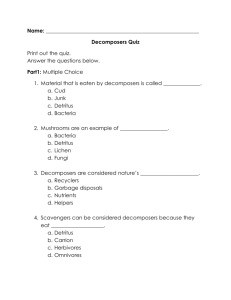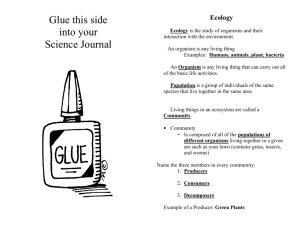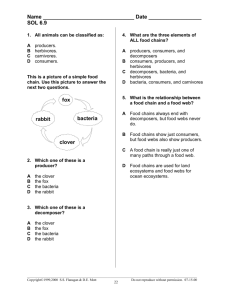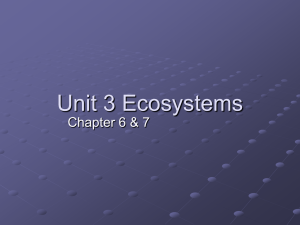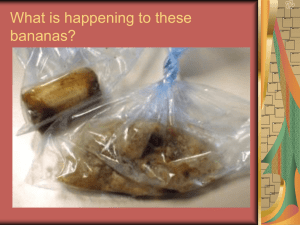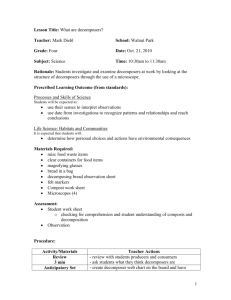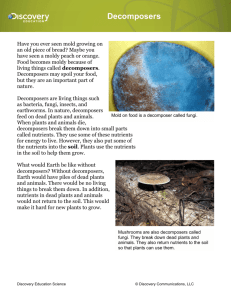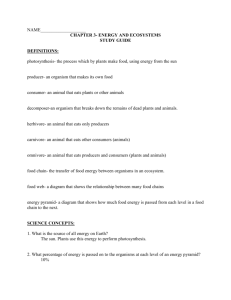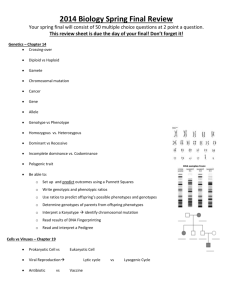Lesson Plan
advertisement
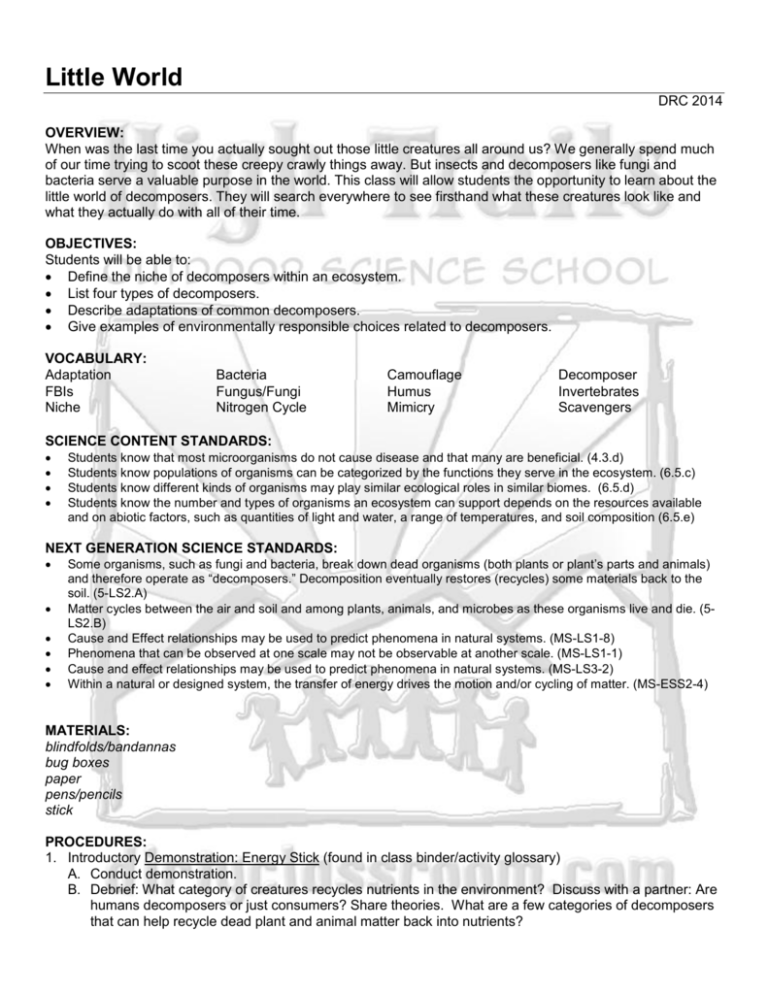
Little World DRC 2014 OVERVIEW: When was the last time you actually sought out those little creatures all around us? We generally spend much of our time trying to scoot these creepy crawly things away. But insects and decomposers like fungi and bacteria serve a valuable purpose in the world. This class will allow students the opportunity to learn about the little world of decomposers. They will search everywhere to see firsthand what these creatures look like and what they actually do with all of their time. OBJECTIVES: Students will be able to: Define the niche of decomposers within an ecosystem. List four types of decomposers. Describe adaptations of common decomposers. Give examples of environmentally responsible choices related to decomposers. VOCABULARY: Adaptation FBIs Niche Bacteria Fungus/Fungi Nitrogen Cycle Camouflage Humus Mimicry Decomposer Invertebrates Scavengers SCIENCE CONTENT STANDARDS: Students know that most microorganisms do not cause disease and that many are beneficial. (4.3.d) Students know populations of organisms can be categorized by the functions they serve in the ecosystem. (6.5.c) Students know different kinds of organisms may play similar ecological roles in similar biomes. (6.5.d) Students know the number and types of organisms an ecosystem can support depends on the resources available and on abiotic factors, such as quantities of light and water, a range of temperatures, and soil composition (6.5.e) NEXT GENERATION SCIENCE STANDARDS: Some organisms, such as fungi and bacteria, break down dead organisms (both plants or plant’s parts and animals) and therefore operate as “decomposers.” Decomposition eventually restores (recycles) some materials back to the soil. (5-LS2.A) Matter cycles between the air and soil and among plants, animals, and microbes as these organisms live and die. (5LS2.B) Cause and Effect relationships may be used to predict phenomena in natural systems. (MS-LS1-8) Phenomena that can be observed at one scale may not be observable at another scale. (MS-LS1-1) Cause and effect relationships may be used to predict phenomena in natural systems. (MS-LS3-2) Within a natural or designed system, the transfer of energy drives the motion and/or cycling of matter. (MS-ESS2-4) MATERIALS: blindfolds/bandannas bug boxes paper pens/pencils stick PROCEDURES: 1. Introductory Demonstration: Energy Stick (found in class binder/activity glossary) A. Conduct demonstration. B. Debrief: What category of creatures recycles nutrients in the environment? Discuss with a partner: Are humans decomposers or just consumers? Share theories. What are a few categories of decomposers that can help recycle dead plant and animal matter back into nutrients? 2. Characteristics of a Decomposer Discussion A. Explain what a decomposer is. Include that the breaking down of matter into usable nutrients is their niche. B. Use the acronym FBIs to describe decomposition. i. Fungi: Fungi decompose by sending out branches of root-like hyphae to break down organic matter. Mold and mushrooms are common examples of fungi. It takes 50-100 years for fungi to break a tree trunk down into dust. ii. Bacteria: Bacteria are microscopic organisms that can live anywhere and are responsible for recycling dead fungi and animal matter. How small are they? 25,000 laid end to end would only be one centimeter! Together with fungi, bacteria are responsible for 80 – 90% of forest decomposition. iii. Invertebrates/Scavengers: Many invertebrates as well as scavengers, like turkey vultures and ravens, break larger dead animals and plants into smaller pieces to be decomposed by fungi and bacteria. Most insects, and other invertebrates, like worms, are largely responsible for the humus layer of the forest floor. This layer is between the freshly fallen leaves/pine needles and above the more compact and dense spoil, made up of decomposing organic matter. **Note: arachnids (spiders) are consumers, not decomposers. 3. The Role of a Decomposer Discussion Needs a better tie in to a student’s life… A. Decomposers keep the forest clean by breaking down dead plants and animals. Imagine if all of the leaves, pine cones and fallen trees from millions of years were still on the ground! They also recycle nutrients, changing nitrogen from the air into a form that can be absorbed by plants. Recycling nitrogen is important because it helps plants produce their food and helps animals, like us, build protein. This process is called the nitrogen cycle. i. Activity: Nitro Tag (Found in the activity glossary/activity video). ii. Conduct Round One. Then pose the question, “Is there enough nitrogen remaining for last omnivore to survive?” iii. Conduct Round Two. iv. Debrief: In which round did you feel more involved? (Round 2) What does capturing another person’s blindfold signify in the second round? (Recycling nitrogen) What niche are you filling if you recycle nitrogen in the ecosystem? What are some things that fix nitrogen in the environment? (bacteria on the roots of legumes like soybeans, peas, clover, other beans etc.) 4. Decomposer Survival A. Review the niche of decomposers (recycle nutrients, keep forest clean). What special adaptations help decomposers survive and do their job? i. Fungi partner with other organisms to help it survive. In lichen, algae gives carbohydrates to fungi in return for nutrients like ammonia and phosphates. Trees do the same thing, sometimes donating 10% of their photosynthetic output to the fungus attached to the roots. ii. Bacteria are very versatile and adapt to different living conditions. Some bacteria can even survive without water for years! Many take hosts as a source of protection and energy. We have thousands of types of bacteria living in our intestines that help us digest our food. Very few bacteria actually harm humans. iii. Invertebrates can have special features that help them survive: (1) Mimicry: some insects look or behave like other things-Giant Silk moths looks like they have big eyes on their back to scare away predators; Walking Stick bug looks like a stick and stays very still; some moths evade bats by pretending to fall out of the sky like leaves. (2) Camouflage: many organisms can blend with their environment; theEarth Fan mushroom hides among the pine duff and the Indian Dead-Leaf butterfly blends perfectly with a bush when it closes its wings. iv. One scavenger, the Turkey Vulture, has a quirky adaptation. It directs urine onto its legs and feet because the strong acid rinses bacteria away that might accumulate when it lands on or near carrion. B. Activity: Invent A Decomposer (found in activity glossary) i. Debrief: Have a few students share their work with a partner. What is your decomposer’s name? Which decomposer’s body plan did you mimic? What is one adaptation that helped your decomposer do its job? Where would your decomposer live? As a group, pose the question: Why do you think there are a variety of decomposers in each ecosystem? 5. Experiment: FBI Hunt A. Now it is time to see what is in the forest around us. Conduct experiment. B. Debrief: Was it easy or difficult to find the different types of FBIs? Why? Many decomposers are very small. Can we identify evidence of decomposers even if we cannot see the insects themselves? 6. Wrap Up A. Review. Tell your partner why decomposers are an important part of an ecosystem. Share. B. Decomposers are small, often microscopic. What can we do in order to help decomposers survive? Don’t squish bugs, limit anti-bacterial soaps, don’t pour pollutants into the soil. C. Hand bead to each student. THINGS TO THINK ABOUT: Special Needs: If the ground is frozen, you may have to get creative in helping students find FBIs. Evidence of decomposition is always prevalent under the bark of a fallen log, etc. Weather: Temperature affects FBIs and the ability to find them. Read In the Forest of S.T. Shrew as an alternative to the FBI hunt if weather is inclement.
